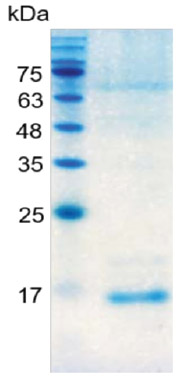


Interleukin-15 (IL-15), Human
GMP Grade Available!
Size: 100 μg
IL-15 regulates T and natural killer cell activation and proliferation. IL-15 and IL-2 share many biological activities. They are found to bind hematopoietin receptor subunits, and may compete for the same receptor, and thus negatively regulate each other’s activity. The number of CD8+ memory cells is controlled by a balance between IL-15 and IL-2. IL-15 induces the activation of JAK kinases, as well as the phosphorylation and activation of transcription activators STAT3, STAT5, and STAT6. Studies of the mouse counterpart suggested that this cytokine may increase
the expression of apoptosis inhibitor BCL2L1/BCL-x(L), possibly through the transcription activation activity of STAT6, and thus prevent apoptosis.
Expression System
Escherichia coli
Sequence
NWVNVISDLKKIEDLIQSMHIDATLYTESDVHPSCKVTAMKCFLLELQVISLESGDASIHDTVENLIILANNSLSSNGNVTESGCKECEELEEKNIKEFLQSFVHIVQMFINTSLE with polyhistidine tag at the N-terminus.
Species
Human
Tag
polyhistidine tag at the N-terminus
Endotoxin Level
<0.01 EU per 1 μg of the protein by the LAL method.
Activity
Measure by its ability to induce NK cells proliferation. The ED₅₀ for this effect is <3 pg/mL. The specific activity of recombinant human IL-15 is approximately >5 x 10⁹ IU/mg.
Purity
>95% as determined by SDS-PAGE. Ni-NTA chromatography
Formulation
The protein was lyophilized from a solution containing 1X PBS, pH 8.0.
Reconstitution
It is recommended to reconstitute the lyophilized protein in sterile H₂O to a concentration not less than 100 μg/mL and incubate the stock solution for at least 20 minutes to ensure sufficient re-dissolved.

SDS-PAGE analysis of recombinant human IL-15



